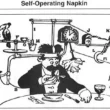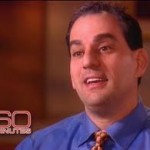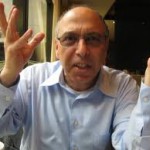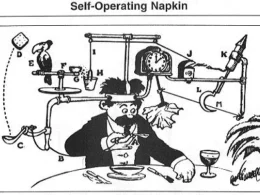Barry Minkow spent last week in plea negotiations regarding a federal indictment on which he is hoping to receive only 5 years, says his lawyer. (LA Weekly: Barry Minkow to plead guilty to insider trading). In December, 2010, a Florida judge threw her proverbial book at Barry Minkow, and it glanced off Sam Antar, who had been paid Barry’s paymaster to the tune of $250,000, Barry had testified. In addition, the judge found as a matter of fact that Sam Antar destroyed documents necessary for her trial. Minkow also gave sown testimony that well-known New York hedge fund manager Whitney Tilson paid him $40,000: more on this below.
Sam Antar, generally not short of opinion, has suddenly developed laryngitis.
Barry Minkow and Sam Antar are two of the most remarkable swindlers in recent American history, each guilty of frauds measured in the hundreds of millions of dollars. Two decades ago their names gave off the same foul stench that Bernie Madoff’s does today. So Deep Capture invites Whitney Tilson to explain why he would join legendarily convicted financial criminal Sam Antar in making payments to also-legendarily convicted financial criminal Barry Minkow, who now is pleading guilty to his 58th financial felony. (You know how to reach me, Whitney. DeepCapture will give you 250 words, with no editing. But we may provide commentary. 😉 )
What is more to the point of DeepCapture, however, is that until this latest turn of events, Barry Minkow and Sam Antar had, notwithstanding their prior convictions on massive financial crimes, successfully repositioned themselves within the US financial media as experts in crime-fighting (see 60 Minutes‘ 2006 puff-piece on Barry Minkow, “It Takes One to Know One”, and Fortune Magazine’s 2007 lotion-job on Sam Antar, “Takes One to Know One“). Barry and Sam used the imprimatur of the mainstream press to return to criminal behavior (which Barry has now acknowledged). The ease with and degree to which the New York financial media swallowed this remarkable bullshit will attest for a generation to the intellectual corruption and broad imbecility of broad swathes of the US financial media.
No, seriously. That really happened. Two convicted financial felons, the Madoff’s of their generation, made comebacks by gulling the financial press into writing lotion-job stories saying that they were now reformed and devoted to stopping crimes, not committing them. Here is UPI on Barry Minkow: “Barry Minkow: Cleaning up, reaching out.” Here is, again, Fortune Magazine from late 2007: “Takes one to know one -Sam Antar, the felonious former CFO of Crazy Eddie, is now teaching students and prosecutors how to spot fraud in public companies.” And then, it turns out, both used their new-found status as authorities to whom the press turned in order to resume their criminal activity, which again, as of yesterday, leaves Barry hoping for only a five year sentence, and his paymaster Sam Antar with laryngitis.
In the spirit of reconciliation and forgiveness, however, I will offer the US financial media one concession: your gullibility is understandable. In high school I had a history professor who brought an actual American Nazi to class, and let us argue with him. For many of my classmates debating the Nazi was like trying to nail Jell-O to the wall. I discovered that only if one can grasp the concept of “complete venality” can one defeat a scoundrel. Many people, however, are intellectually helpless against such people, because deep down they cannot grok the possibility that anyone can spin and lie and spin and lie and spin and lie and spin some more, then lie and lie on top of it.
I believe that the preceding accurately describes the mentality of some US journalists who gave these knuckleheads more credit than they should have. For others, however, giving credence to Sam Antar or Barry Minkow was simply an expression of an ideological commitment: those publications favor Wall Street over the United States, and they were willing to give credence to Barry and Sam’s work in order to further the agenda of Wall Street, which is more or less the purpose of their publications.
I know that is a lot to accept. So don’t trust me, trust a Florida state court judge, The Honorable Gill Freeman, who brought her hammer down on Barry Minkow. Judge Freeman’s entire opinion can be read here: Order Granting Lennar’s Motion for Sanctions–Dec 27 2010 (warning: It is so scathing one almost feels sorry for them. Or, well… maybe not.)
I cannot help resist quoting at length from it: as you read Judge Freeman’s words, please remember my description of the American Nazi.
THIS CAUSE came before the Court on Plaintiffs Motion for Sanctions and for entry of default and other relief against Defendants Barry Minkow and the Fraud Discovery Institute, Inc. for their willful and egregious litigation misconduct. The parties filed extensive papers in support and in opposition of the motion, and the Court held a two-day evidentiary hearing on August 26 and 27, 2010 at which time Mr. Minkow was examined by Plaintiffs’ and Defendants’ counsel, as well as the Court.
Having carefully considered all the papers, the evidence filed by both parties, evidence introduced at the hearing, including Mr. Minkow’s testimony, and arguments of counsel, it is ORDERED and ADJUDGED that Plaintiffs’ Motion be, and the same is hereby, GRANTED as set forth below, based on the following findings of fact and conclusions of law.
With full knowledge of the rules and his obligations as a litigant in this Court, Mr. Minkow has withheld key documents, destroyed or discarded important evidence, concealed the identity of material witnesses, willfully violated court orders, and engaged in actions to cloud his misconduct. Minkow repeatedly intentionally misrepresented these matters to his own lawyers, in sworn affidavits filed with this Court, at depositions in this case, and at the evidentiary hearing itself, including in response to questions from this Court. Mr. Minkow was repeatedly impeached by his own documents, documents he never produced in this case as to material issues. The evidence clearly and convincingly established that Minkow has acted knowingly, unilaterally, and improperly in deciding what evidence is relevant and what information Lennar, the Court, and his lawyers should and should not know.
Minkow’s misconduct has been pervasive, intentional, and committed to gain unfair advantage over Plaintiffs and to deceive this Court. Lennar and its counsel spent numerous hours investigating Minkow’s activities in this litigation, and evidence which Plaintiffs have repeatedly requested has been discarded and/or irretrievably lost.
Plaintiffs’ right to fair process and trial has been severely and irrevocably compromised. No remedy short of default, together with full reimbursement of the attorneys’ fees and costs incurred in connection with Plaintiffs’ extensive and continuous efforts to obtain evidence and discovery, can restore Plaintiffs to “the position [it] would have occupied in the absence of [Minkow’s] willfulness and bad faith.”
…
In its papers and at the evidentiary hearing, Lennar introduced substantial evidence that Minkow created and tendered false documents in this case.
…
Fact No.7: In this case, Minkow has been represented by three experienced, capable attorneys: Alvin Entin and Joshua Entin of Florida, and Michelle Baker of California. The Court finds that Minkow misled his attorneys multiple times on material issues.
…
Fact No.9: Minkow testified he could not recall whether he sent the letter to any person with whom he worked on the Lemlar investigation, including Tracy Coenen, Terry Gilbeau, Paul Palladino, Jeff Sachs, Sam Antar, or Shannon Boelter, or otherwise instruct any person to preserve documents in connection with this litigation. [emphasis added]
…
Fact No. 11: The evidence also showed that Tracy Coenen, Terry Gilbeau and Sam Antar deleted emails about Lennar they had exchanged with Minkow…
…
Fact No. 21: On October 7, 2009 Minkow submitted an affidavit swearing that he had produced all documents in his possession, custody, and control responsive to Lennar’s document demands and this Court’s June 15 and July 9, 2009 Orders. (Ex. 10 at”if”if 5-7; Ex. 8; Ex. 16; Ex. 20.)
Fact No. 22: These sworn statements in Minkow’s October 7, 2009 affidavit were false. At the time he represented that he had made a complete production, Minkow had possession, custody, or control of numerous documents responsive to Lennar’s document demands and this Court’s June 15 and July 9, 2009 Orders, including but not limited to, the following documents material to this case:
• a version of the November 30, 2008 engagement agreement between Minkow and Nicolas Marsch containing a six-page, 11-point “confidential proposal” (Ex. 202); .
• another version of the November 30, 2008 engagement agreement between Minkow and Nicolas Marsch containing materially different compensation terms (Ex. 200);
• numerous emails with Mr .. Marsch, Paul Palladino, Tracy Coenen, Sam Antar,Terry Gilbeau, Shannon Boelter, and other individuals involved in the Lennar investigation;
Fact No. 23: Minkow knew he had possession, custody, or control of these and other documents, but made the decision to withhold them.
…
Fact No. 25: At the August 26,2010 hearing, Minkow admitted that he withheld these documents and others but said it was “negligent” because, at the time he represented he had produced all responsive documents, Minkow was working “18 hours a day” filming a movie about his life and he was “swamped and overwhelmed.” The Court does not find this testimony credible and rejects this excuse.
Fact No. 26: On several subsequent occasions, when he was not filming a movie including as recently as August 11, 2010, Minkow continued to withhold documents and falsely represent that he had produced all documents in his possession, custody, or control responsive to Lennar’s document demands and this Court’s June 15 and July 9, 2009 Orders.
Fact No. 27: On each occasion, Minkow knew he had possession, custody, or control of such documents responsive to the Court’s Orders, but he–alone-made
the decision to withhold them.
Fact No. 28: Minkow’s year-long withholding of documents was not inadvertent, accidental, or negligent.
Fact No. 29: Minkow withheld documents he perceived to be harmful to his case. Among other things, the concealed documents demonstrate:
• that Minkow’s investigators questioned the accuracy of statements of fact he included in his report on Lennar;
• the perfunctory nature of Minkow research and investigation before he accused Lennar and its executives of operating like a ponzi scheme, giving its COO a disguised kickback, being a financial crime in progress, and other statements; and
• Minkow’s use of possibly illegal means to obtain personal, confidential information about Lennar, its executives, and others.
Fact No. 30: By withholding these documents, Minkow wilfully violated the Court’s June 15,2009 Order and the Court’s July 9, 2009 Order.
…
Fact No. 31: Minkow introduce~ no credible evidence to substantiate his assertion that he was unable to produce documents because his Hewlett Packard computer was stolen, crashed, and/or was hacked.
Fact No. 32: The evidence showed that in February 2010, Minkow was named as a defendant in another matter by a company called Medifast, Inc. … Lennar is not a party to that case.
Fact No. 33: In April and May 20 I 0, Medifast had· served Minkow with requests for documents in their case. On July 1, August 10,16, and 23,2010, Minkow produced more than 4,000 pages of documents to Medifast, including scores of emails. Among the documents produced to Medifast were documents that should have been, but were not, produced in this case despite this Court’s June 15 and July 9,2009 Orders.
Fact No. 34: When confronted at the evidentiary hearing with a document from the Medifast production, but not produced here, one that was responsive to Lennar’s document requests-Minkow testified, “I never even thought this had anything to do with it… What in the world would make me think I had to tum it over to Lennar?”
Fact No. 35: This testimony is not credible and, even if it were, demonstrates Minkow’s contemptuous disregard for the rules of litigation and his belief that he–not the Court-determines what is relevant.
Fact No. 36: The documents Minkow produced to Medifast-but not in this case-refute Minkow’s testimony that he was unable to produce emails in this case because his computer had been stolen, crashed, and/or hacked.
Fact No. 37: Lennar has incurred great expense to procure some evidence from third parties, and it is highly probable considerably more evidence that Minkow should have produced has been withheld, deemed irrelevant by Minkow himself, concealed and/or destroyed. Due to Minkow’s misconduct, neither Lennar nor the Court has any way of knowing the nature, extent, or volume of evidence that should have been produced but has been concealed and destroyed.
…
Fact No. 40: Minkow had represented that the Hewlett Packard computer on which he performed the vast majority of work related to his investigation of Lennar (and on which he had exchanged untold numbers of emails with Tracy Coenen, Terry Gilbeau, Paul Palladino, Jeff Sachs, Sam Antar, Shannon Boelter and others) had earlier been hacked, and likely was destroyed and/or discarded; after Minkow was added as a defendant in this case, after being served with a preservation letter, after being served with a Notice of Deposition Duces Tecum requiring the production of documents, and after Plaintiff had filed its first sanctions motion.
Fact No. 41: Minkow has not introduced any credible evidence that all information from the Hewlett Packard was copied, duplicated, stored, and preserved without the loss of discoverable evidence.
Fact No. 42: Minkow admitted that the transfer of his email archives from the Hewlett Packard to a new computer was “incomplete.”
Fact No. 43: On July 21,2010, the Court ordered Minkow to appear and provide testimony at an evidentiary hearing scheduled for August 4, 2010. The
Court allowed Minkow to appear in San Diego and provide testimony via videoconference.
Fact No. 44: Lennar made significant preparations to arrange the videoconference for the hearing on August 4.
Fact No. 45: On July 30,2010, Minkow agreed to voluntarily appear live in Miami at the evidentiary hearing scheduled for August 4, 2010.
Fact No. 46: Lennar relied on Minkow’s representation and Lennar’s counsel made significant preparations to attend and examine Minkow in person at the
hearing on August 4 in Miami.
Fact No. 47: On the morning of August 3, 2010, Minkow informed the Court that he would not attend the hearing scheduled for August 4, 2010 in person or via video conference from California. Minkow asserted that on August 2, 2010, while in Los Angeles awaiting a flight to Miami, he became ill and went to the emergency room at a Los Angeles hospital. Minkow represented that he was restricted from traveling to Florida for the hearing.
Fact No. 48: On August 4 and 10, 2010, the Court ordered Minkow to produce, among other things, evidence that he had been to the emergency room / hospital.
Fact No. 49: Ten days later, on August 20, 2010, Minkow submitted an affidavit wherein he admitted that he had not gone to the emergency room. Minkow had lied to Plaintiffs, the Court, and his own lawyers.
Fact No. 50: Minkow swore that he could not “recall” what he had said to his lawyers and his assistant the morning of August 3, 2010 because he was on pain medications. The Court does not find this testimony credible.
Fact No. 51: The Court finds that Minkow intentionally deceived Plaintiffs and the Court regarding the emergency room visit because he knew that such a claim would require this Court to postpone the August 4, 2010 hearing.
Fact No. 52: At the August 26,2010 hearing, Minkow testified that he “didn’t think it [whether he went to the emergency room] mattered. I had a doctor verifying I was ill, and I thought that is all that mattered.”
Fact No. 53: This testimony is not credible and demonstrates Minkow’s contemptuous disregard for the rules of litigation and his belief, again, that he-not the ermines what is relevant.
Fact No. 54: At the August 26, 2010 hearing, when Minkow was impeached by the fax header on his own doctor’s letter, Minkow testified for the first time that the assistant who picked him up in Los Angeles was not in San Diego, California, as he earlier had testified, but rather was in Orange County, California.
Fact No. 55: This testimony contradicts his affidavit ofless than a week earlier in which he swore that his assistant “drove to Los Angeles from San Diego, California.”
Fact No. 56: When confronted with his contradictory. affidavit, Mr. Minkow testified that the location of his assistant was “irrelevant.”
Fact No. 57: This testimony is not credible and demonstrates Minkow’s contemptuous disregard for the rules of litigation and his consistent belief that he, not the Court, determines what is relevant.
…
PERVASIVENESS OF MINKOW’S MISCONDUCT
Fact No. 95: Minkow’s withholding and destruction of evidence, concealment of witnesses, and false testimony constituted a fraud on the Court.
Fact No. 96: Minkow has displayed no regard for the Court’s Orders, his testimonial oaths, the administration of justice, or his obligations as a litigant.
Fact No. 97: Minkow had ample opportunity to correct his misconduct and avoid sanctions. Minkow chose not to do so.
Fact No. 98: Minkow has wrongfully acted as though it is his right, not that of the Court, to determine what documents are relevant, what issues are material, and what information the Plaintiffs, the Court, and even his own lawyers should and should not know.
Fact No. 99: Minkow has displayed no appreciation of, or remorse for, the burden and expense that his withholding and destruction of evidence, concealment of
witnesses, false testimony, and other misconduct have caused Plaintiffs and the Court.
Fact No. 100: The Court finds that the likelihood Minkow would comply with his discovery obligations or the Court’s Orders in the future is unlikely.
Remember what I said above about the American Nazi? How if someone lies and spins and lies and lies some more, they can actually keep going for a long time? When you catch them out in a lie, they often apologize, say they are sorry. Lots of them even cry (really, I see it every time I deal with sociopaths). They then continue with a new lie, a new spin, until you catch them again. They just keep going and going.
That is a pretty fair description of Judge Freeman’s description of Barry Minkow. Withhold evidence and lie about it by saying the evidence was destroyed; Destroy the evidence then lie about that; when confronted, say that your computer was hacked and that evidence is gone (even though it is not); when told to appear in court, claim that you have been in an emergency room; when asked for evidence you were in an emergency room, say that a doctor gave you advice; when confronted with the fact that the doctor’s letterhead reveals a forgery that shows you were lying, change the city. And so on and so forth.
Incidentally, this pattern continues almost to this day. In February, 2011, LA Weekly reported: “Pastor Barry Minkow’s Community Bible Church Hit by $50,000 Burglary; Ex-conman Minkow Has a History of Faked Burglaries”.
I assume that Barry will go find God again, or claim he was off his medications, or or or. A guy like this can never own what he does. However, simply as a tactical matter, he can apologize. That will come someday, and he will sound sincere, and Fortune Magazine or Bloomberg or Portfolio Magazine will trumpet the redemption of a fraudster, who will then go on and attack a list of companies that bears striking resemblance to the list of companies being bet against by the favorite hedge fund sources of those same publications.
However, I would like to draw attention to the names “Tracy Coenen” and “Sam Antar“, which appeared repeatedly in the judge’s order. “The evidence also showed that Tracy Coenen, Terry Gilbeau and Sam Antar deleted emails about Lennar they had exchanged with Minkow,” wrote Judge Freeman. They destroyed emails, says the judge, but “Minkow testified he could not recall whether he sent the letter” Tracy Coenen and Sam Antar instructing them to preserve documents.
So Tracy and Sam just happen to have deleted all their email traffic on the precise subject of the lawsuit, and did so in some magically irrecoverable way. Sure, it happens all the time. “What judge, those emails? Oh, I was watching NBA and hit my laptop’s magic delete key and all those emails vanished from my laptop, and from my server, and coincidentally as I passed in front of my microwave my hard drive got wiped the recommended 3-7 times to US Department of Defense clearing standard DOD 5220.22, and gosh, I’m sorry, but none of those emails can be recovered.”
The strangest thing about such folks, like the strangest thing about the American Nazi, is the fatuity with which they tell lies, knowing they are lies, knowing that you know they are lies, and knowing that you know that they know that you know they are lying. I have had to deal with it a few times in business settings, and it really is remarkable. Again, only when they are completely cornered (and I have had reason to do so on occasion), they burst into tears, own everything they did as long as you have already proven it, promise they will never do it again, and watch out of the corners of their eyes to see if you are buying it. Like Barry Minkow is probably doing in a federal interview room right now.
That is the dynamic you need to be understand in order to comprehend people like this. Those familiar with Sam Antar’s work will recognize how his modus operandi is indistinguishable from his friend Barry’s: the rules do not apply, just lie and attack and lie and attack and lie and pretend to do “fraud research” as a cover for your own criminal activity, and chum friendly journalists into buying into it all, and hope no one digs deeper into your smears.
That said, now that you understand the nature of Barry Minkow, might it be worthwhile for some actual journalist to pursue the following line of research:
- Judge Freeman found as Fact 29: “Among other things, the concealed documents demonstrate the perfunctory nature of Minkow research and investigation before he accused Lennar and its executives of operating like a ponzi scheme, giving its COO a disguised kickback, being a financial crime in progress, and other statements”. In other words, Minkow took payments, did bogus research, then made wild criminal accusations. The Feds have now hit him with criminal charges, and he is (according to his lawyer) in the middle of plea bargaining, hoping to get only 5 years. But Minkow is small potatoes. He was paid to do these things by someone. Who was paying Minkow?
- Barry Minkow testify under oath that Sam Antar, paid him over $250,000 in two wires in 2006. But Sam Antar is a bankrupt, and claims to be broke. Do broke people normally send quarter-million dollar wires?
- Barry Minkow testified (see around 9:59) that Whitney Tilson, the well-known New York hedge fund manager, paid Minkow $40,000 to write a “report”? Does that strike anyone as odd? Given how “perfunctory” Minkow’s investigations are, why would a money manager like Whitney Tilson pay Barry Minkow? When Whitney Tilson took his clients’ funds to manage, did he tell them that he would be making decisions based on the insights of the inestimable Barry Minkow? Or, did Whitney Tilson pay Barry Minkow for other reasons?
If we actually had journalists in this country, they would not need this laid out in such a paint-by-the-numbers fashion.
Still, hope springs eternal….











Dear Mr. Byrne,
Thank you for not settling with the enemy.
Thank you for not being bought, bullied or browbeaten into backing off.Thank you for keeping alive the belief in a higher ideal, for not taking what you can get and running, for fighting the fight for all of us who see the wrong but have no way to fight it.
Heinlein may have been wrong about the type of monster we would be fighting for our freedom, he wrote of a religious tyranny not a financial one, yet he was right about the need to defend our country from within and I am sure he would have cheered your efforts and techniques. Keep it up!
I know very well there is no such thing as a free lunch , if you can use any help from us in the peanut gallery you just let me know when and where,if you can use the help of a simple housewife.
Again thank you,
bbhindyou
Talking to a fellow the other day, a derivatives trader. He was on the desk in 08. They were just middlemen, but some guy got on the internet, and said the guy’s firm was insolvent. Crushed the stock. Cost hm millions.
They eat their own.
There needs to be such punitive penalties for this type crime that are so onerous, no one would even think about it. I sat there and watched the Lennar debacle, knew what he was doing, and knew they wouldn’t stop him.
How much did these pricks cost the average investor?
David Einhorn and Other Funds Lost $1.39 Billion Shortselling Porsche
March-18-2011
After the most infamous short squeeze in recent memory, several hedge fund managers have sued Porsche (PAH3.DE) for $1.39 billion of losses.
39 investment funds including David Einhorn’s Greenlight Capital filed a suit against Porsche last year. The basis of the suit is that Porsche allegedly misrepresented it’s plans to take over Volkswagen (VOW.DE). The hedge funds allege that Porsche was manipulating the stock market in a brazen attempt to cause a short squeeze.
The reason the takeover is disputed is that Porsche ($94 billion market cap) is about one third of the size of Volkswagen ($240 billion market cap) making the takeover a ridiculous proposition.
In October 2008, Porsche disclosed that it owned owned 42.6 percent of Volkswagen stock. Porsche also disclosed that it had acquired options for another 31.5 percent.
Many prominent hedge funds including Greenlight Capital, SAC Capital and Tiger Management sold short shares of Volkswagen.
Porsche controlled a large percentage of the share float and the German state of Lower Saxony owned another 20 percent stake in VW. Lower Saxony was not interested in selling it’s shares. Porsche requested that hedge funds buy back borrowed stock even though Porsche only owned call options on the shares.
There were almost no shares left to buy in order to cover the short positions. The price of Volkswagen shares skyrocketed from €200 to above €1,000 in two trading sessions. For a small window of time, VW was the world’s most valuable company.
The horrific short squeeze also caused he death of German billionaire Adolf Merckle who threw himself in front of a train on Tuesday January 6 2009 after losing hundreds of millions of euros short selling Porsche stock.
As for Minkow, his manipulative put options in six companies he was investigating (Pre Paid Legal, Herbalife, Inter Oil, Medifast, Usana, and Lennar) created a loss for Investorsof
$ 2.4 BILLION!!!
Lennar investors lost $840 million alone!
A swindler.
Maybe a false prophet.
He might talk and deal himself a short easy sentence for the first one.
If the second is true, and he is a false prophet, well he better fess up or no pity. Ever!
I think you change the name of Minkow on most of what you reported especially the lies, lies, lies and replace it with the name Cramer and it would fit like a glove.
And to think I saw a Cramer advertisement on this site… I almost like the lady with the stupid hat better.
I can’t tell you how many times I have read posts radiating animosity by the hordes of full-time, “financially-disinterested”, venom-spewers using the “Wacky Patty” reference, as if it were the buzzword agreed upon during a basher strategy session. These tools of the short-and-distort racketeers (if they are not the miscreant shorters themselves) ALWAYS use the tactic of responding to reports exposing their racket with a broad brushstroke of lunacy paint in a very vague shade.
They have used this tactic from the small-scale message board level to the large-scale mainstream financial media level. With your last two articles, however, you have clearly been vindicated (once again).
Now, many gullible average people who blindly accepted the cheap shots supported by the mainstream media must have had an epiphany. Surely they now realize how right you have been and how easily they were mislead while average investors were robbed by those posing as philanthropists and volunteer cyber-vigilantes.
Please continue your very laudable truth crusade. The markets CAN be a better place thanks to such efforts.
Tilson is advertising his annual Value Investing Congress to be held the first week in May in Pasadena CA. If you sign up now, you can save something like $1400. I assume you will be able to learn about companies whose shares have been beaten down enough to be a real “value,” or maybe even about a few prospects whose share prices are about to be beaten down. Just speculating, of course.
Needs A New Ending Indeed……”A JailHouse Ending”
http://articles.latimes.com/2011/mar/19/business/la-fi-minkow-movie-20110319
Einhor, et al. will now have the ability to further decimate bank stocks:
http://www.nytimes.com/2011/03/22/business/22bizcourt.html?src=busln
Is it as simple and innocent as this, or is there more to it?
Invest Like A Fish
By Jonah Lehrer March 21, 2011 | 10:50 am | Categories: Frontal Cortex, Science Blogs
My latest WSJ column is on a very cool new paper in PNAS by Serguei Saavedra, Kathleen Hagerty and Brian Uzzi that looks at synchronous behavior in humans.
What does it take to become a better investor? The answer is to think like a fish.
Let me explain. When small fish face an extremely difficult problem—an attack, say, from several predators at once—they deal with it by forming a school. This is an example of synchronous behavior, in which individuals quickly coordinate their actions. There is no leader, but that doesn’t matter. The school arises spontaneously.
In a forthcoming paper, scientists at Northwestern University show that the best stock traders at a leading hedge fund act a lot like those scared fish. Instead of coping with predators, of course, these traders are grappling with a surfeit of information, from confusing quarterly statements to reams of economic data. Their job is to act quickly—buying and selling shares—based on the latest news.
What’s interesting is that these traders don’t make sense of all this information alone. Rather, they constantly interact with each other, mostly by instant message (IM). They “disambiguate” the numbers together.
The scientists were interested in how this flurry of electronic communication influenced trader performance. After getting access to the internal files of the hedge fund, they analyzed every IM sent by 66 day traders over an 18-month period. They discovered that these traders sent out an astonishing number of messages, more than two million exchanges over the course of the study, the average trader engaging in 16 IM conversations at a time.
But this ceaseless messaging wasn’t a distraction. Instead, it allowed traders to pool their information. “Everyone is in a race to figure out what’s happening first,” says Brian Uzzi, a senior author on the paper. “There’s real pressure to make a decision, but you also want to make sure that you make the right decision.”
This is much harder than it sounds. The scientists found, for instance, that even these experienced traders only made money, on average, from 55% of their stock trades. Not surprisingly, hedge funds and investment firms have long searched for ways to increase these odds. That’s why they employ elaborate quantitative models and track all sorts of metrics on individual traders, from volume of trades to levels of testosterone.
According to the Northwestern researchers, however, these firms should be tracking instant messages instead. After a burst of messages in response to a news event, the traders often acted in sync, converging on the same conclusion and executing a large number of trades at the exact same time. (These IMs typically featured short bits of analysis and did not involve the spread of insider information.) Although they weren’t trying to coordinate their buying and selling, they ended up acting together, just like a school of fish moving as one.
This synchronous behavior proved to be an immense advantage. Though typical traders barely beat random chance, those acting at peak moments of sync made money on more than 70% of their stock trades. They also made nearly twice as much money per trade, which explains why traders who frequently “sync up” were the best performers at the firm. (The worst traders, by contrast, were the ones who instant-messaged the least.) “These plugged-in traders have an edge that puts them in a superclass,” Mr. Uzzi says. “What’s interesting is that their edge comes from the crowd, from everyone else around them.”
At the moment, it’s unclear how individual investors or financial firms can take advantage of synchronous behavior. One possibility that Mr. Uzzi suggests is to “double-down” on investments that occur when traders are synced, since those are so much more likely to be profitable. “When you see a lot of IM traffic, and then traders within the firm start acting in unison, the odds are that’s going to be a good decision,” he says. “Those are the trades that I’d bet on.”
For too long, we’ve subscribed to an overly individualistic model of success. If a trader is particularly effective, we tend to assume that he or she must have some special talent, some uncanny ability to decipher the market. But that’s probably not the case. This research reminds us that the best traders can only be understood as part of a network. Fish make sense of the world by coming together. So do we.
On a sidenote, this paper should redeem, at least a little, the intellectual reputation of instant messaging. When I first heard that the day traders were engaged in 16 IM conversations simultaneously, I assumed they would show a drop-off in performance due to multitasking, much like a teenager trying to do his homework while messaging with friends. But that, of course, wasn’t the case. Instead, the short texts proved to be ideally suited to the collective “disambiguation” of financial news. Is this setup unique to day traders? What other professions might benefit from a flurry of IMing?
May be a Tad off topic but very interesting in the fact that “They” said this never existed…’If there were only a pattern”
http://www.housingwire.com/2011/03/22/finra-fines-sw-securities-expels-cutler-securities-for-naked-short-selling
I’m surprised there aren’t more revelations. Where are the whistleblowers?
As of today Alvin Entin, Minkow’s Fort Lauderdale-based attorney, has been granted his motion (filed on March 11) to withdraw from the case….probably couldn’t handle the “con”going lies…..
Shapiro hot on the trail of 1987 crimes and misdemenors:
“SEC’s Schapiro: New rules needed for market risksRelated stories
Egypt bourse slumps in truncated trading session (10:21a)
Xoma, Prana pressure biotech stocks (11:10a)
Looking for opportunities in Japan (12:01a)
Divide the stock market to conquer it (12:01a)
Story Comments Screener (3) Share Yahoo! Buzz
MySpace
del.icio.us
Reddit
LinkedIn
Fark
StumbleUpon
Newsvine
|Recommend PrintEmail AlertBy Ronald D. Orol WASHINGTON (MarketWatch) – The Securities and Exchange Commission should consider adopting rules requiring that market participants acquire technology to assure the can function in volatile market conditions, agency chairwoman Mary Schapiro said Wednesday. After “Black Monday” in October 1987, when stock markets around the world crashed, the SEC developed policy statements, not rules, setting-out expectations that market participants acquire appropriate technology. However, Schapiro said, with risks including “algorithm-generated volume surges and malevolent hackers still very much with us,” the agency should consider converting those policy statements into stricter rules. The rules could require regular capacity planning, testing exercises, system vulnerability assessments and an annual independent review. “In my view, these rules should reinforce the current expectation that registrants report systems changes, malfunctions and intrusions to the SEC and disclose material problems to the public,” Schapiro told a gathering of the Securities Industry and Financial Markets Association. ”
Folks, we, and America, are screwed. Thanks SEC!
RSS feed follow up
Hi there,
Just following up from my recent email about your RSS feed being published to Before It’s News.
I’m the Business editor at Before It’s News. Our site is a People Powered news platform with over 2.5 million visits a month and growing fast.
We would be honored if we could republish your blog RSS feed in our Business category. Our readers need to read what Deep Capture has to say.
Syndicating to Before It’s News is a terrific way spread the word and grow your audience. Many other organizations are using Before It’s News to do just that. We can have your feed up and running in 24 hours. I just need you to reply with your permission to do so. Please include the full name and email of the person who will be attached to the account, and let me know the name you want on the account (most people have their name or their blog name).
You can also have any text and/or links you wish appended to the end or prepended to the beginning of each of your posts on Before It’s News. Just email me the text and links that you want at the beginning and/or ending of each post. If you know html you can send me that. If not, just send me the text and a link to your site. It should be around 200 characters or less (not including links).
You can, if you like, create a custom feed for Before It’s News that includes multiple links back to your blog or web site. We only require that RSS feeds include full stories, not partial stories. We don’t censor or edit work.
Thank you,
Chris Holehouse
Editor, Before It’s News
http://www.beforeitsnews.com
Does it end?
http://www.businessweek.com/news/2011-03-24/kkr-received-request-from-sec-in-sovereign-wealth-fund-probe.html
Minkow will receive a “SLAP ON THE WRIST” for more Fraud !!
http://online.wsj.com/article/SB10001424052748704438104576219662795056534.html?reflink=barrons_redirect
http://investorshub.advfn.com/boards/board.aspx?board_id=17129
Did the trial reveal anything about naked short selling that took place, which was probably involved in the mechanism of how the stock was attacked? What we need is evidence showing complicity of brokers and even the DTCC in these activities.
Fred,
See my response below.
This is a very beautiful wtbisee, I have enjoyed my visit here very much. I’m very honoured to sign in your guestbook. Thanking you for the great work that you are doing here.
That’s the next level. The trial mentioned here was a civil suit, but has subsequently led federal action.
The key is to keep jamming people up, flipping them, and working your way up the food chain. That’s the traditional law enforcement way of taking down an organized crime syndicate.
Or you map the network and then target the critical nodes to disrupt and fracture the network, and then stomp out the remnants. This is the method used by Joint Special Operations Command against terrorist networks, and it can be applied to law enforcement.
Department of Justice Press Release
For Immediate Release
March 24, 2011 United States Attorney’s Office
Southern District of Florida
Contact: (305) 961-9000
Barry Minkow Charged with Conspiracy to Manipulate Common Stock of Fortune 500 Company
Wifredo A. Ferrer, United States Attorney for the Southern District of Florida, and William J. Maddalena, Acting Special Agent in Charge, Federal Bureau of Investigation (FBI), Miami Field Office, announce the filing of a criminal information charging Barry Minkow, 44, of San Diego, California, with conspiracy to manipulate the stock price of Lennar Corporation (Lennar), a former Fortune 500 company doing business in Miami-Dade, by making false and misleading statements about Lennar’s business operations and management. Minkow is expected to make his initial appearance in federal court next week.
According to the charging document, Minkow operated Fraud Discovery Institute, a for-profit fraud investigation firm based in California. In this way, Minkow developed ties with federal law enforcement agencies as a purported fraud-finder. Today, Minkow was charged with making false and misleading statements alleging wide-spread improprieties in Lennar Corporation’s financial reporting and business structure, and attacking the personal character of Lennar’s management.
According to the information, Minkow was hired to put economic pressure on Lennar to pay money demanded by a business partner in a prior land deal. To this end, beginning in January 2009, Minkow used the Internet, press releases, e-mail communications, Youtube.com videos, and the U.S. mail to broadcast false and misleading statements about Lennar, with the intent of artificially depressing Lennar’s stock price.
In addition, the Information alleges that Minkow abused his relationship with federal law enforcement agencies to report false allegations of criminal conduct purportedly committed by Lennar and its management. Once Minkow confirmed that his allegations had successfully induced law enforcement to open a criminal investigation, Minkow allegedly used that knowledge and information to trade Lennar securities for his own benefit.
U.S. Attorney Wifredo Ferrer stated, “In this case, Minkow’s manipulation of the market and his relationship with the FBI for his personal gain caused a severe drop in the stock prices of a large local corporation. This type of deceit and abuse of trust will not be tolerated. Together with the FBI and the cooperative efforts of the SEC, we will investigate and prosecute stock manipulation cases to help protect the integrity of our capital markets.”
William J. Maddalena, Acting Special Agent in Charge of the FBI’s Miami Office, stated, “When false statements are disseminated to deceive the investing public, whether they’re designed to prop up a company or tear it down, the FBI will dedicate all available resources to bring disseminators of such falsehoods to justice.”
If convicted, Minkow faces a statutory maximum penalty of five years in prison.
Mr. Ferrer commended the investigative efforts of the FBI and the cooperative efforts of the Miami Regional Office and the Washington DC Office of the Securities and Exchange Commission. This case is being handled by Assistant U.S. Attorneys Ryan Dwight O’Quinn and Cristina Perez Soto.
An Information is only an accusation and is not evidence of guilt. A defendant is presumed innocent until proven guilty.
A copy of this press release may be found on the website of the United States Attorney’s Office for the Southern District of Florida at http://www.usdoj.gov/usao/fls. Related court documents and information may be found on the website of the United States District Court for the Southern District of Florida at http://www.flsd.uscourts.gov or http://pacer.flsd.uscourts.gov.
http://miami.fbi.gov/dojpressrel/pressrel11/mm032411.htm
…convicted felon
…formal relationship with the fbi as a confidential human source
…duty to protect confidential info disclosed to him
…willfully, that is, with intent to further the object of the conspiracy, and knowinly combine, conspire, confederate and agree with conspirator A and with others
…conspiracy was for the defendant and his conspirators to artifically manipulate
…confirmed that his false and misleading report successfuly induced a law enforcement agency to open a criminial investigation
http://www.justice.gov/usao/fls/PressReleases/Attachments/110324-01.Information.pdf
pending charges for others/conspirators?
this topic is a series of discussion where everybody gets to comment and give their own opinion.
Interesting reading.Last week I stepped back
and really looked at what I wanted to achieve with my blogs.